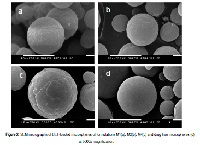Development and in vitro evaluation of mucoadhesive microsphere carriers for intranasal delivery of betahistine dihydrochloride
Keywords:
MénièreÊs syndrome, chitosan microparticles, mucoadhesion, nasal delivery, sustained releaseAbstract
The aim of the present work was to formulate and evaluate betahistine-loaded chitosan microspheres intended for nasal delivery with focus on their mucoadhesive properties. Betahistine-loaded chitosan microspheres were obtained via W/O emulsion solvent evaporation technique and were characterized for particle size, surphace morfology and entrapment efficiency. FTIR spectroscopy was carried out to evaluate drug-polymer interaction and powder X-ray diffractometry was applied to investigate crystallinity transformations. Tensile studies were carried out using sheep nasal mucosa to evaluate in vitro mucoadhesion. Drug release into phosphate buffer saline pH 7.4 was performed and dissolution profiles of the formulations were obtained. The results showed that the microspheres were spherical in shape having smooth surface and mean particle size of 3.82 øm to 7.69 øm which is appropriate for optimum deposition in the nasal cavity. The mean particle size increased when chitosan solutions with higher viscosity were used. In vitro mucoadhesion studies indicated that chitosan microspheres had good mucoadhesive properties and could adequately adhere to nasal mucosa. It was observed that polymer concentration enhancement led to increased mucoadhesive strength. Betahistine release studies from the microspheres showed similar and slightly icreasing dissolution profiles. Acording to the obtained results, betahistine-loaded chitosan microspheres prepared by solvent evaporation method proved to be capable of sustained release and could be used via nasal route as an alternative to oral administration.
References
. Lacour M, Heyning PH, Novotny M, Tighilet B. Betahistine in the treatment of Ménière’s disease. Neuropsychiatric Disease and Treatment. 2007;3(4):429–440.
. Botta L, Mira E, Valli S, Zucca G, Perin P, Benvenuti C, Fossati A, Valli P. Effects of betahistine and of its metabolites on vestibular sensory organs. Acta Otorhinolaryngol Ital. 2001;21(3 Suppl 66):24–30.
. Chávez H, Vega R, Valli P, Mira E, Benvenuti C, Guth PS, Soto E. Action mechanism of betahistine in the vestibular end organs. Acta Otorhinolaryngol Ital. 2001;21(3):8-15.
. Della Pepa C, Guidetti GF, Eandi ML. Betahistine in the treatment of vertiginous syndromes: a meta-analysis, Acta Otorhinolaryngol Ital 2006;26:208-215.
. Williams RO, Taft DR, McConville JT. Advanced drug formulation design to optimize therapeutic outcomes. New York: Informa Healthcare; 2008.
. Alagusundaram M, Chengaiah B, Gnanaprakash K, Ramkanth S, Madhusudhana C, Dhachinamoorthi D. Nasal drug delivery system - an overview. Int J Res Pharm Sci. 2010;1(4):454-465.
. Bitter C, Suter-Zimmermann K, Surber C. Nasal drug delivery in humans. Curr Probl Dermatol. 2011;40:20–35.
. Dhuria SV, Hanson LR, Frey WH. Intranasal delivery to the central nervous system: mechanisms and experimental considerations, J Pharm Sci. 2010;99(4):1654-73.
. Touitou E, Barry BW. Enhancement in drug delivery. Kentucky: Taylor & Francis Inc; 2010.
. Yadav VK, Gupta AB, Kumar R, Yadav JS, Kumar B. Mucoadhesive polymers: means of improving the mucoadhesive properties of drug delivery system. J Chem Pharm Res. 2010;2:418-432.
. Mathiowitz E. Encyclopedia of Controlled Drug Delivery, Vol. 1 & 2, New York: John Wiley & Sons; 1999.
. Vasir JK, Tambwekar KR, Garg S. Bioadhesive microspheres as a controlled drug delivery system. Int J Pharm. 2003;255:(1-2)13-32.
. Sinha VR, Singla AK, Wadhawan S, Kaushik R, Kumria R, Bansal K, Dhawan S. Chitosan microspheres as a potential carrier for drugs. Int J Pharm. 2004;274:1–33.
. Patil SB, Sawant KK. Chitosan microspheres as a delivery system for nasal insufflation. Colloids Surf B Biointerfaces. 2011;84:384–389.
. Jadhav KR, Gambhire MN, Shaikh IM, Kadam VJ, Pisal SS. Nasal drug delivery system-factors affecting and applications. Current Drug Therapy. 2007;2:27-38.
. Shaikh RS, Raj Singh TR, Garland MJ, Woolfson AD. Mucoadhesive drug delivery systems. J Pharm Bioallied Sci. 2011;3(1):89–100.
. Davidovich-Pinhas M, Harari O, Bianco-Peled H. Evaluating the mucoadhesive properties of drug delivery systems based on hydrated thiolated alginate. J Control Release. 2009; 136:38-44.
. Tangri P, Khurana S, Satheesh Madhav NV. Mucoadhesive drug delivery: mechanism and method of evaluation. Int J Pharm & Bio Sci. 2011;2(1):458-467.
. Mishra M, Mishra B. Mucoadhesive microparticles as potential carriers in inhalation delivery of doxycycline hyclate: a comparative study. Acta Pharmaceutica Sinica B. 2012;2(5):518–526.
. Parmar H, Bakliwal S, Gujarathi N, Rane B, Pawar S. Different methods of formulation and evaluation of mucoadhesive microsphere. Int J App Bio Pharm Tech. 2010;1(3):1157-1167.
. McGinity JW, O'Donnell PB. Preparation of microspheres by the solvent evaporation technique. Adv Drug Deliv Rev. 1997;28(1):25-42.
. Jyothi NV, Prasanna PM, Sakarkar SN, Prabha KS, Ramaiah PS, Srawan GY. Microencapsulation techniques, factors influencing encapsulation efficiency. J Microencapsul. 2009;1(3):1-31.
. Pereswetoff-Morath L. Microspheres as nasal drug delivery systems. Adv Drug Deliv Rev. 1998;29:185–194.
. Tiwari S, Verma P. Microencapsulation technique by solvent evaporation method (Study of effect of process variables). Int J of Pharm & Life Sci. 2011;2(8):998-1005.
. Rosca IO, Watari F, Uo M. Microparticle formation and its mechanism in single and double emulsion solvent evaporation. J Control Release. 2004;99(2):271-80.
. Georgieva V, Zvezdova D, Vlaev L. Non-isothermal kinetics of thermal degradation of chitosan. Chem Cent J. 2012;6(1):81-90.
. Borade RB, Mahajan YY, Jadhav NP, Kokane JV, Usman MdR, Potdar MB. Bioadhesive multiparticulate (microspheres) drug delivery system: a review. J Drug Del & Ther. 2013;3(2):176-185.
. Morris GA, Castile J, Smith A, Adams GG, Harding SE. Macromolecular conformation of chitosan in dilute solution: A new global hydrodynamic approach, Carbohydrate Polymers. 2009;76:616–621.
. Cunha RA, Soares TA, Rusu VH, Pontes FJS, Franca EF, Lins RD. The molecular structure and conformational dynamics of chitosan polymers: an integrated perspective from experiments and computational simulations. In: Karunaratne DN, editor. The Complex World of Polysaccharides. New York: InTech; 2012.
. Peppas NA, Thomas JB, McGinity JW. Molecular aspects of mucoadhesive carrier development for drug delivery and improved absorption. J Biomater Sci Polym Ed. 2009;20(1):1-20.
. Jelvehgari M, Hassanzadeh D, Kiafar F, Loveymi BD, Amiri S. Preparation and determination of drug-polymer interaction and in-vitro release of mefenamic acid microspheres made of celulose acetate phtalate and/or ethylcellulose polymers, ranian J Pharm Res. 2011;10(3):457-467.
. Costa P, Sousa Lobo JM. Modeling and comparison of dissolution profiles, Eur J Pharm Sci. 2001;13(2):123–133.





